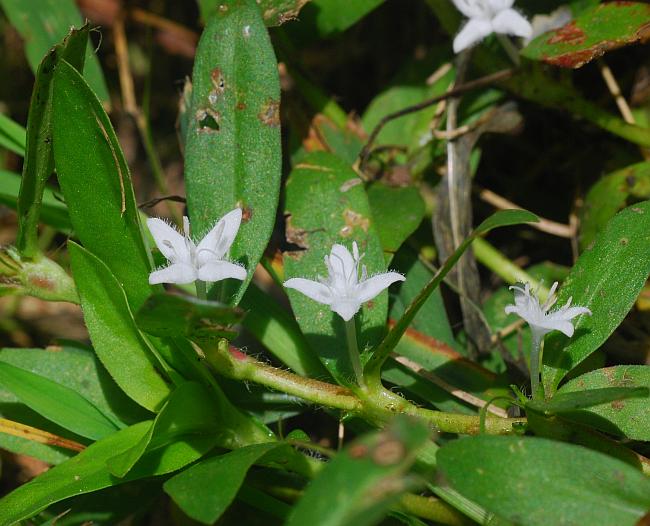Diodia virginiana L.
Large Buttonweed

Native
CC = 5
CW = -3
MOC = 25
© SRTurner
Diodia virginiana L.Large Buttonweed | |
 |
Native CC = 5 CW = -3 MOC = 25 |
© SRTurner |
|
Family - Rubiaceae Habit - Annual forb, occasionally short-lived perennial. Stems - Prostrate or loosely ascending from a spreading base, to 40 cm, 4-angled, often with reddish tinge, sparsely to moderately pubescent with short or sometimes longer, straight to wavy hairs. Leaves - Opposite, simple, sessile. Pairs of opposing leaves joined at base by sheathing stipules, these 2.0-4.5 mm long, with 3-7 bristles on the upper margin, variously 2-7 mm long. Leaf blades 1.2-7.0 cm long, 2-15 mm wide, narrowly elliptic to oblong-lanceolate, angled at the base, angled to a sharply pointed tip, the margins minutely pubescent with stiff, spinescent hairs, flat, the surfaces glabrous short-hairy, the undersurface finely glandular-hairy along the midvein, the venation with the midvein and usually 2-4 pairs of pinnate, secondary veins visible.
Inflorescence - Single or double flowers from most leaf axils. Flowers sessile.
Flowers - Calyces deeply 2-lobed, the lobes 2-8 mm long, lanceolate to triangular, often unequal. Corollas 10-13 mm long, 4-lobed, bright white, externally glabrous or nearly so, internally bearded in the throat with the pubescence usually extending onto the lobes, the tube 6-7 mm long, the lobes 5-6 mm long, spreading, lanceolate. Stamens 4, alternating with corolla lobes, adnate at apex of corolla tube, exserted. Filaments to 4 mm long, white, glabrous. Anthers 2 mm long, white. Style 1.1 cm long, glabrous, filiform, flattened. Styles 2-branched, with long, linear stigmas. Ovary 2-locular.
Fruits - Schizocarps 6-7 mm long, 4-5 mm wide, ellipsoid to broadly ellipsoid, with well-developed longitudinal ridges on the sides, becoming corky, eventually splitting longitudinally into halves, pubescent to glabrous.
Flowering - June - September. Habitat - Pond margins, bottomland prairies, mesic swales of sand prairies, fens, streambanks, levees, ditches, roadsides, moist, open, disturbed areas. Origin - Native to the U.S. Lookalikes - None close. Other info. - This species can be found as far north in Missouri as Lincoln County, but is far more common in the southern part of the state, where it can be somewhat weedy when it finds optimal habitat. The south of Missouri lies along the northern border of the plant's natural range, which extends throughout the southeastern quadrant of the continental U.S. When flowering, the plant is easy to identify from its creeping habit and bright white, 4-lobed flowers. Up close the flowers are seen to have hairy corolla lobes. The fruits are corky and float on water, which probably plays a part in dispersal. Photographs taken in the Croatan National Forest, NC., 7-11-02 (DETenaglia); also at Otter Slough Conservation Area, Stoddard County, MO, 7-18-2009 and 7-31-2015, Onondaga Cave State Park, Crawford County, MO, 8-20-2014, and Millstream Gardens Conservation Area, Madison County, MO, 9-3-2020 (SRTurner). |